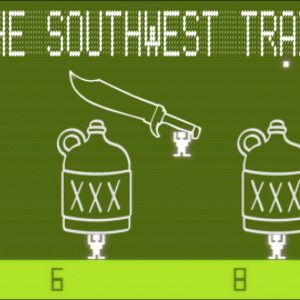calsfoundation@cals.org
The Southwest Trail [Computer Game]
2021 April Fools' Day Entry
The Southwest Trail was a 1987 text-based computer game designed by the Minnesota Educational Computing Consortium (MECC) as a follow-up to that company’s highly successful game The Oregon Trail, in which the player assumes the role of the leader of a wagon train following the trail from Missouri to Oregon. However, The Southwest Trail, which follows settlers from the St. Louis, Missouri, area through Arkansas and on to Texas, was much less popular than its predecessor, being seen largely as a cheap imitation of the first. In addition, the game drew criticism for misrepresenting Arkansas in several important ways.
The original Oregon Trail game was designed by Don Rawitsch in 1971 for use in his eighth-grade history class. Three years later, Rawitsch took a job at MECC and updated the game significantly before making it available to schools in 1975. The game immediately proved popular and went through several versions in the coming years. After its 1980 release on floppy disk for the Apple II as part of MECC’s Elementary series (in volume 6, where it had the shortened title Oregon), company leaders began to consider employing the same general theme and game mechanics, but with a focus upon other historical trails, in part to broaden interest to other parts of the United States. After the release of the 1985 version of The Oregon Trail, the most well-known entry in the series, to wide acclaim (it would be available for several different platforms in the coming years), company leaders began the push in earnest.
As it happened, one MECC programmer was acquainted with Little Rock (Pulaski County) programmer Danielle Bunten Berry, who had recently founded the company Ozark Softscape and had already made a name for herself in the gaming world, most notably with her 1983 release M.U.L.E., a multiplayer game that tackled some of the same issues of supply and demand present in The Oregon Trail. In a phone conversation with MECC representatives, Berry pitched the idea of doing a game based upon the Southwest Trail, the network of routes that traversed Arkansas from the northeast to the southwest in the nineteenth century. MECC loved the idea and began to work on it immediately. Although Berry had hoped that Ozark Softscape might be involved in the development of the new game, MECC ultimately decided to pursue this latest venture without its involvement—or, indeed, the involvement of anyone in the states covered by the Southwest Trail.
This proved a poor decision on the part of MECC. While Rawitsch and others, in the various versions of The Oregon Trail, had been careful to make the gameplay as realistic as possible, drawing from actual accounts of settlers who traveled the trail, the programmers at MECC who worked on The Southwest Trail did not take such care with their new project. As a consequence, players were confronted with occasional attacks by Sioux Indians on their way through the state, despite the fact that 1) the Sioux were actually located far to the north of Arkansas, and 2) no Native Americans in Arkansas during the territorial period ever committed any attack upon white settlers. In fact, The Southwest Trail also reused many of the same graphics from The Oregon Trail and so rather poorly represented the geography of Arkansas; at one point where players must cross the Cache River, the game shows a bright blue waterway from atop a high bluff, rather than the sluggish, brown-green, lowland waterway that is the actual Cache River.
While such aspects of the game had little connection to Arkansas history or geography, other aspects reinforced stereotypes of Arkansas as a backward place. For example, in The Oregon Trail, the player leads a party of five other white settlers, and at various points along the way, such as at forts throughout the West, one can buy or trade food, clothing, oxen, parts of a wagon, and bullets. However, in The Southwest Trail, one can also buy and trade moonshine, which becomes an important commodity not only for personal consumption, but also for trade with the locals. One notorious event the player might encounter goes as follows: “Two toothless hillbillies, armed with shotguns and Bowie knives, emerge from the woods and demand that you squeal like a pig.” The options facing the player in this situation are: 1) Try to shoot them, 2) Squeal like a pig, 3) Offer them moonshine, 4) Offer them money, 5) Offer them the youngest child, 6) Ignore them. A review of the game in the May 17, 1985, issue of Computerworld magazine described this particular scene as “immensely inappropriate in an educational game for children, referencing as it does the infamous rape scene from Deliverance,” adding, “What are children supposed to learn about frontier life, or about basic morality, from these stark and strange choices?” In fact, the only relatively inoffensive concession to state uniqueness was the game’s replacement of the prevalence of dysentery among the wagon train with the disease of malaria.
Upon the game’s release on April 1, 1987, state officials swiftly condemned The Southwest Trail and made it clear that no one from Arkansas had actually participated in its development. Governor Bill Clinton had for many years been attempting to chart a more progressive vision of state politics and directed state education leaders to develop no curricula that would encourage the playing of The Southwest Trail. In a late April Nightline interview with Ted Koppel on the subject, Clinton defended his state’s reputation: “Arkansas is not now, and never was, the sort of place depicted in that computer game. Also, I want to remind everyone that the movie Deliverance was set in Georgia—and filmed there.” In an April 29 guest column in the Arkansas Gazette, historian Michael Dougan wrote, “If those programmers at MECC had an ounce of conscience, they would have died not of dysentery but of shame.”
Despite the blowback, MECC refused to withdraw the game from circulation, but sales were sluggish compared to The Oregon Trail, and so The Southwest Trail was not developed for other platforms and had no sequels. MECC’s later attempts to develop further trail-based educational entertainment would avoid the American South entirely. In 1993, MECC released The Amazon Trail, which entailed a river-based journey to a lost Inca village, followed the next year by The Yukon Trail, which was set during the Klondike Gold Rush. In the twenty-first century, The Southwest Trail remains available only on various “retro-gaming” websites, playable on modern computers through an emulator.
April Fools!
For additional information:
Blevins, Brooks. Arkansas/Arkansaw: How Bear Hunters, Hillbillies, and Good Ol’ Boys Defined a State. Fayetteville: University of Arkansas Press, 2009.
Dougan, Michael. “Minnesota Rude!” Arkansas Gazette, April 29, 1987, p. 8B.
Polestone, Mikkael. “The Southwest Trail Reviewed: Decent Gameplay No Excuse for Inappropriate Themes.” Computerworld, May 17, 1987, p. 42.
Wanda Hackett
Arkansas Educational Computing Network
 Divergent Prosperity and the Arc of Reform, 1968–2022
Divergent Prosperity and the Arc of Reform, 1968–2022 Education, Elementary and Secondary
Education, Elementary and Secondary The Southwest Trail
The Southwest Trail 



Comments
No comments on this entry yet.